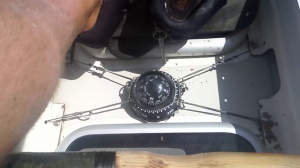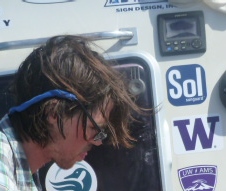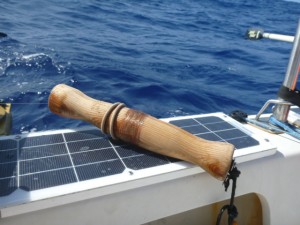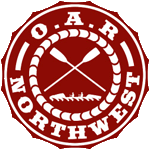
So we have been billing our little vessel as “the world’s most technologically advanced rowboat.” Although our hull is no longer made of the latest materials and designs, we have a glut of fancy/awesome electronics that – a la our power situation (hopefully resolved now) – we have been struggling to keep working… Prognosis: optimistic.
However, as my friend and teammate Brad Vickers from the 2006 row said to me in an email after we broke the second oar, “the ocean is good at showing us how little we need.” It made me think of everything we have on the rowboat and what the ocean has decided we don’t need anymore.

Shortly after that wave crashed on us and broke our first oar, the RD-33 navigation display began to short. This amazing bit of equipment is what we use to steer the boat with. It displays heading, location, speed over ground, speed over water, air temp, wind speed, pressure water temp, pitch, roll, and even more information from our instruments. Now while we are still collecting this information, we don’t have access to it. What do do? We went analog.
We have a compass we mounted to the deck. There was really no place to secure it so I built a frame for it to sit in out of some wire, drilled four holes on the inside of the tracks, and used some super strong string and several well-placed knots to secure it. It displays our magnetic heading and we can double-check the course periodically from the display inside the cabin. This is what we have been using to navigate the majority of our trip. We put a flashlight on it to navigate at night.

When that first oar-breaking wave hit, we also lost one of our electronic scheduling devices. That was OK because we have three (always bring backups of the important stuff!). We also lost our fishing rod. That’s OK because we have some hand line and plenty of hooks.
Losing the second oar was a bit more troubling – now we were down to four oars. Any more breakage and we are either rowing one person at a time, or turning the boat into a sailboat using our broken oars and some sheets. More on this later when I outline our contingency plans. Until then, the ocean continues to decide what we need and what we want.
